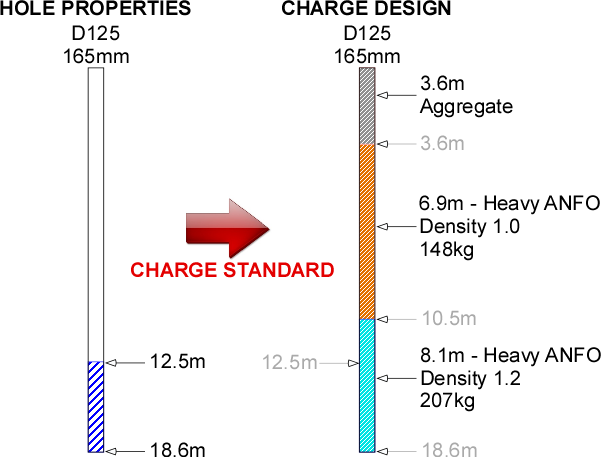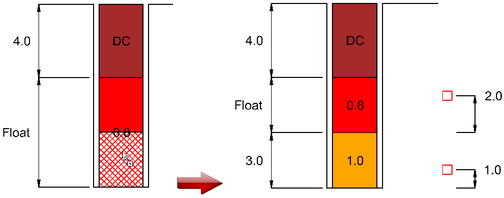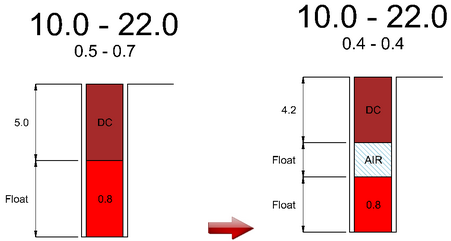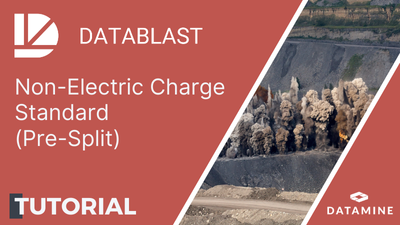Conventional Charge Standards
Conventional charge standards define how hole depth and conditions are transformed into a detailed charge design.

Each conventional charge standard represents a matrix of definitions of how to charge holes based on length range and hole type. For each definition, you need to specify the products and other settings.
You can specify as many hole length ranges as required. The minimum deck length is 0.1 m.
The following hole types are predefined:
- Dry—Applied to holes that have no water identified in the Measure Module.
- Wet—Applied to holes where water is recorded in a dip measurement in the Charge Module. Wet charge standards have standing water and are generally loaded with a full-column pumpable bulk explosive.
- Dewatered—Applied to holes that have both a water depth recorded and the dewatered flag set. Dewatered holes may have a water resistant toe charge under a dry column charge. The toe charge length is modified by the recorded water or wet wall depth.

Charge Standard Decks
Decks can be filled with either explosive or inert products.
- Explosive:
- Bulk—The bulk explosive fully couples the blast hole.
- Packaged—The packaged explosive has a fixed diameter that must be less than the hole diameter.
- Inert—Air, water, gas bags, aggregate or drill cuttings.
Decks can have a fixed or floating length.
- Fixed—Defined length or mass.
- Floating—Expand so that the standard covers the range of lengths. Every charge standard definition must have a least one floating deck. If there are multiple floating decks, the split displays as a percentage.
Rules for deck loading:
- Every explosive deck must either contain a booster or be in direct contact with a deck that contains a booster.
- Explosive decks separated by an air deck must have the same delay.
- Every charge standard definition must have at least one floating deck.
- The minimum deck length is 0.1 m.
- The diameter of packaged explosives must be less than the hole diameter.
- Augered products cannot be directly loaded over pumpable products.
When you add a deck, the location where the deck is to be added is highlighted. A new deck splits an existing deck.

Powder Factor Management
The powder factor (PF) displays in the definition diagram under the length increment. The unit of measure is kilograms per cubic metre (metric) or pounds per cubic foot (imperial).
Note: All diagrams in this topic display metric values.
The powder factor often increases if a fixed stemming is loaded. As the hole increases in length, the proportion of the hole loaded with explosives increases and consequently so does the powder factor.
One way to control the change in powder factor is to add a floating inert deck.

Primers
Primers generally consist of detonators and a booster but may be a detonator only.
Primers may be anchored to any of the deck interfaces shown on the deck layout.

Example of a Conventional Charge Standard Definition

These videos, recorded using an earlier version of DataBlast Pro, provide examples of configuration of non-electric charge standards.



